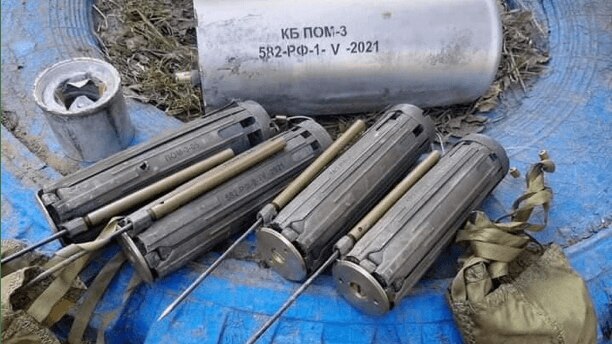War in Ukraine: Banned worldwide, Russian mine that hides itself in soil
The newly developed POM-3 landmines detect approaching footsteps then obliterate anything within a 16m radius.

Russia is using anti-personnel mines in northeastern Ukraine which detect approaching footsteps then obliterate anything within a 16m radius, a human rights report has found.
The newly developed POM-3 landmines, banned under international treaties, were discovered in Kharkiv on Monday by Ukrainian ordnance disposal technicians.
Known as “Medallion” mines, the devices are designed to be fired by rocket launchers and descend by parachute before burying or fixing themselves in the ground.
They are equipped with a “seismic detector” capable of registering when someone is approaching before launching a bomb into the air. The blast and shrapnel can indiscriminately kill or injure anyone within the blast radius, Human Rights Watch reported.
If no one triggers a POM-3 mine, it can apparently self-destruct after a certain amount of time, which could be hours or days after deployment.
Producing, stockpiling and transferring anti-personnel mines is banned under the 1997 international Mine Ban Treaty, but Russia is not among the 164 countries that subscribe to it.
The mines in Kharkiv are said to have been delivered in rockets fired from ground launchers, possibly on Saturday.
Footage circulated online that day shows what experts believe is an ISDM Zemledelie-I rocket launcher sending dozens of mines into the air.
The system is capable of deploying mines from 5km to 15km away and, according to the Landmine Monitor 2021 report, appeared during annual Russian military exercises in 2021.
Depending on the terrain on which the mines land, they are intended to bury themselves to become hard to spot, or use spring-loaded feet to stay upright until triggered. The minefield is visible to Russian forces on an electronic map and can be remotely deactivated if necessary.
Human Rights Watch said a delivery canister remnant pictured in Ukraine contained POM-3 mines that failed to deploy properly. Markings indicated it was produced last year.
“Countries around the world should forcefully condemn Russia’s use of banned antipersonnel landmines in Ukraine,” Steve Goose, director of the group’s arms division, said. “These weapons do not differentiate between combatants and civilians and leave a deadly legacy for years to come.
“Russia’s use of antipersonnel mines in Ukraine deliberately flouts the international norm against use of these horrid weapons.”
The deployment of antipersonnel mines “marks a rare circumstance”, the campaign group said. This is because Russia is not party to the 1997 treaty but is using the weapons on Ukraine, which signed the commitment on February 24, 1999, and became a state party to the treaty on June 1, 2006.
Russia told the UN General Assembly in 2020 that it “shares the goals of the treaty and supports a world free of mines”, but views anti-personnel mines “as an effective way of ensuring the security of Russia’s borders”.
The admission came after the use of anti-personnel mines of Russian origin was documented in more than 30 countries, including in Syria, Ukraine and Libya, by Human Rights Watch.
The discoveries “often coincided with Russian military presence as a party in those conflicts”, the group said.
Anti-vehicle mines can also be deployed by the ISDM launcher that has been seen firing into Ukraine. The POM-3 can be scattered by other types of truck-mounted launchers.
Ida Sawyer, the campaign group’s crisis and conflict director, said: “Countries around the world should forcefully condemn their use.”
Russian state television claimed this month that Ukrainian forces laid thousands of anti-tank or anti-personnel mines in Donbas and around Crimea.
Open source analysts online said the destructive patterns of some Russian tanks in Ukraine indicated that they had triggered anti-tank devices in the ground.
The Times



To join the conversation, please log in. Don't have an account? Register
Join the conversation, you are commenting as Logout